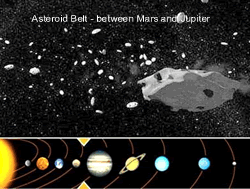 Asteroids are sometimes called called minor planets or planetoids. The term asteroid is generally used to indicate a diverse group of small celestial bodies in the solar system that orbit around the Sun that can't be called a planet or a comet.
"Asteroid" is Greek for "star-like". It is the most commonly used word in the English literature for minor planets while other languages prefer the term "Planetoid" which is Greek for "planet-like". That is a better term because it more or less describes what they are! (Stars they ain't!).
Planets tend to be virtually spherical but asteroids are often irregular shapes as they do not have enough gravity to be pulled into the sphere shape.
 The first spherical asteroid in the asteroid belt to be discovered, Ceres, is the largest asteroid yet discovered. It is now classified as a dwarf planet (like Pluto). All others in the asteroid belt are currently classified as 'small solar system bodies'. The vast majority of asteroids are found within the main asteroid belt. They follow elliptical orbits between Mars and Jupiter. One theory is that these asteroids are remnants of the protoplanetary disc (see star formation), and in this region their pulling together into a larger planet or planets during the formative period of the solar system was prevented by large intermittent gravitational tugs by Jupiter. The first spherical asteroid in the asteroid belt to be discovered, Ceres, is the largest asteroid yet discovered. It is now classified as a dwarf planet (like Pluto). All others in the asteroid belt are currently classified as 'small solar system bodies'. The vast majority of asteroids are found within the main asteroid belt. They follow elliptical orbits between Mars and Jupiter. One theory is that these asteroids are remnants of the protoplanetary disc (see star formation), and in this region their pulling together into a larger planet or planets during the formative period of the solar system was prevented by large intermittent gravitational tugs by Jupiter.
Some asteroids have their own moons (natural satellites that orbit them) or are found in co-orbiting pairs known as binary systems. Classification is not simple and a lot of discussion goes into deciding what class a newly discovered body will be. |


